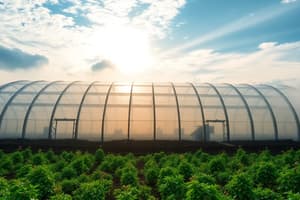Podcast
Questions and Answers
What is the maximum percentage of water vapor that can be found in the atmosphere?
What is the maximum percentage of water vapor that can be found in the atmosphere?
- 1%
- 4% (correct)
- 2%
- 5%
Transpiration occurs primarily in oceans, seas, and rivers.
Transpiration occurs primarily in oceans, seas, and rivers.
False (B)
What is the name of the layer that separates the troposphere and stratosphere?
What is the name of the layer that separates the troposphere and stratosphere?
Tropopause
In the mesosphere, meteors burn up due to the __________ temperature.
In the mesosphere, meteors burn up due to the __________ temperature.
Match the following atmospheric layers with their characteristics:
Match the following atmospheric layers with their characteristics:
Where are higher concentrations of dust particles typically found?
Where are higher concentrations of dust particles typically found?
The stratosphere is characterized by a high concentration of water vapor.
The stratosphere is characterized by a high concentration of water vapor.
What is the lapse rate in the troposphere?
What is the lapse rate in the troposphere?
What percentage of the atmosphere's total mass is confined to the height of 32 km from the earth's surface?
What percentage of the atmosphere's total mass is confined to the height of 32 km from the earth's surface?
Carbon dioxide is opaque to incoming solar radiation.
Carbon dioxide is opaque to incoming solar radiation.
What gas acts as a filter for ultraviolet rays in the atmosphere?
What gas acts as a filter for ultraviolet rays in the atmosphere?
The form of water present in the atmosphere is called ______.
The form of water present in the atmosphere is called ______.
Which of the following gases is primarily responsible for the greenhouse effect?
Which of the following gases is primarily responsible for the greenhouse effect?
The amount of water vapour in the atmosphere increases with altitude.
The amount of water vapour in the atmosphere increases with altitude.
The ozone layer is found mainly between ______ km above the earth’s surface.
The ozone layer is found mainly between ______ km above the earth’s surface.
Match the following components of the atmosphere with their descriptions:
Match the following components of the atmosphere with their descriptions:
Flashcards
Water Vapor in Atmosphere
Water Vapor in Atmosphere
Water in gaseous form found in the atmosphere, reaching there through evaporation and transpiration.
Troposphere
Troposphere
Earth's lowest atmospheric layer (closest to the surface), where weather occurs.
Tropopause
Tropopause
Boundary between the Troposphere and Stratosphere.
Stratosphere
Stratosphere
Signup and view all the flashcards
Stratopause
Stratopause
Signup and view all the flashcards
Mesosphere
Mesosphere
Signup and view all the flashcards
Mesopause
Mesopause
Signup and view all the flashcards
Dust Particles (Atmosphere)
Dust Particles (Atmosphere)
Signup and view all the flashcards
Composition of Atmosphere
Composition of Atmosphere
Signup and view all the flashcards
Atmosphere's Mass Distribution
Atmosphere's Mass Distribution
Signup and view all the flashcards
Carbon Dioxide's Role
Carbon Dioxide's Role
Signup and view all the flashcards
Global Warming Cause
Global Warming Cause
Signup and view all the flashcards
Ozone Layer Function
Ozone Layer Function
Signup and view all the flashcards
Atmospheric Gases at Altitude
Atmospheric Gases at Altitude
Signup and view all the flashcards
Importance of Water Vapor
Importance of Water Vapor
Signup and view all the flashcards
Study Notes
Composition and Structure of the Atmosphere
- Atmosphere is a mixture of gases, water vapor, and dust particles surrounding Earth.
- Air is essential for life, containing oxygen for humans/animals and carbon dioxide for plants.
- 99% of atmospheric mass is within 32 km of Earth's surface.
- Air is colorless and odorless, felt as wind.
Atmospheric Composition
- Gases, water vapor, and dust particles make up the atmosphere.
- Proportions of gases change with altitude.
- Oxygen is almost insignificant at 120 km altitude.
- Carbon dioxide and water vapor are found up to 90 km.
Carbon Dioxide
- Carbon dioxide is crucial for Earth's temperature regulation.
- Transparent to incoming solar radiation but opaque to outgoing terrestrial radiation.
- Absorbs/reflects terrestrial radiation back to Earth (greenhouse effect).
- Carbon dioxide levels have increased recently due to fossil fuel burning, contributing to global warming.
Ozone
- Ozone is another important atmospheric component.
- Found between 10-50 km above Earth's surface (ozone layer).
- Acts as a filter, absorbing UV radiation from the sun, preventing it from reaching the Earth's surface.
- Ozone layer is primarily located in the stratosphere.
Water Vapor
- Water vapor is the gaseous form of water in the atmosphere.
- Source of precipitation.
- Amount decreases with altitude and latitude (more near equator).
- Key role in Earth's temperature regulation (acts as blanket).
Dust Particles
- Found in lower atmospheric layers.
- Types vary (sand, soot, salt, ash, pollen).
- Higher concentration in subtropical/temperate regions.
- Condensation nuclei, forming clouds.
Atmospheric Structure
- Divided into layers based on temperature changes.
Troposphere
- Lowest atmospheric layer (0-7 to 20 km above Earth's surface).
- Weather phenomena occur here.
- Temperature decreases with altitude.
- Contains water vapor, dust particles.
Stratosphere
- Above troposphere (0-50 km).
- Very dry (little water vapor).
- Important for flight due to steady winds.
- Contains the ozone layer.
- Temperature increases with altitude (due to ozone absorption of UV).
Mesosphere
- Above stratosphere (50-85 km).
- Coldest atmospheric layer.
- Meteors burn up in this layer.
- Temperature decreases with altitude.
Thermosphere
- Above mesosphere (80-400 km).
- Temperature rises significantly with altitude (because of radiation absorption).
- Radio waves are reflected by this layer.
- Aurora and satellites occur here.
Ionosphere
- Lower portion of the thermosphere.
- Contains electrically charged particles (ions) created by solar/cosmic radiation.
Exosphere
- Outermost atmospheric layer.
- Molecules escape into space.
- Extends to 10,000 km.
Studying That Suits You
Use AI to generate personalized quizzes and flashcards to suit your learning preferences.
Related Documents
Description
Explore the composition and essential elements of Earth's atmosphere in this quiz. Understand the role of gases, including carbon dioxide and ozone, in maintaining life and regulating temperature. Test your knowledge on the atmospheric layers and the importance of air for life on Earth.




